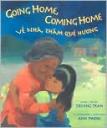 Going Home, Coming Home
Going Home, Coming Home
- publisher and date: Children’s Book Press, 2003
- genre: realistic fiction
- age/grade: ages 6-9
Synopsis: from www.bn.com
Ami Chi is traveling to Vietnam, where the streets are crowded with scooters and the fruit are shaped like dragons and stars. Her parents still consider Vietnam home. But Ami Chi is confused. How can home be a place you’ve never been? She finds her answer in the green rice paddies that blanket the countryside, in the bustling Cho Lon market, and in the quiet rooms of her grandmother’s house. Vietnam may be nothing like America, but it feels strangely familiar. Before long, Ami Chi finds that you can travel very far and still find yourself at home
Author’s Perspective: Truong Tran writes from an insider’s perspective. In his introduction to the book, he writes that he left Vietnam when he was 5 years old. He learned English, and continued to hear stories about Vietnam and speak Vietnamese while he was growing up. He often felt like he was going back and forth between 2 worlds.
Literary Elements:
Character – The main character, Ami Chi, learns that home can be in more than one place and contain more than one culture. She can be both American and Vietnamese. The story is told through her point of view.
Setting – Most of the book takes place in Vietnam. We experience Vietnam through Ami Chi’s first visit with her family. At first everything from the heat, the sounds, and smells are overwhelming to her. As the story progresses she sees the beauty of Vietnam and it starts to feel like home.
Theme – The mixing of cultures, Ami Chi feels she is an American and learns that she can be both American and Vietnamese.
Tone and Style– This book is written in both English and Vietnamese. The story has a quiet, gentle feel to it. The illustrations add to this feel.
Curriculum Connections:
- Beyond My Backyard – a unit of lesson plans developed by Abigail Leyh
- Create a journal of Ami Chi’s trip. Pretend you are Ami Chi, documenting her own trip to Vietnam. Draw pictures of the things she has seen and write short captions for them.
- Write a letter — Pretend you are Ami Chi and write a letter to Thao now that you are back in America.
Web Resources:
- Article about Truong Tran from Papertiger.org
- eight margins – a poem by Truong Tran
- Pictures from a Vietnamese market
Reviews:
Publishers Weekly (from www.bn.com)
In this intimate bilingual tale bridging two cultures, Tran and Phong, both natives of Vietnam who now live in California, write and paint from the heart (both the English and Vietnamese versions of the text appear on each spread). Eight-year-old American-born Ami Chi narrates as she describes a trip with her parents to Vietnam. She questions why her mother and father “still think of it as home”-even though they haven’t been back since they left as children during the war. Initially, Ami Chi complains that Vietnam is too hot, that her grandmother’s house is too small (it’s “no bigger than our garage back home”) and that she can’t understand the language. Phong’s lush landscapes drenched in green convey the country’s beauty, and predominantly red interiors emanate the warmth of the grandmother’s home. Several scenes of the market, where Ami Chi becomes separated from her parents, allow readers a wider view of the culture, as the heroine meets a girl who is a kindred spirit, and who helps to change Ami Chi’s perspective. The narrative occasionally becomes cloying (“The rain is a neighborhood friend who knocks on your door and asks if you can come out to play”), but the author delivers a message that will strike a familiar and reassuring chord with first-generation Americans. Ages 6-up. (Aug.) Copyright 2003 Reed Business Information.
School Library Journal (from www.bn.com)
PreS-Gr 2-Eight-year-old Ami Chi makes her first trip to Vietnam, her parents’ homeland, and stays with her uncle and grandmother. The heat, the small house, and her inability to understand the language make the child long to return home to America-until she visits a market, makes a friend there, and develops a closeness with her grandmother. She realizes that “Home is two different places, on the left and right sides of my heart.” Told through Ami Chi’s eyes, the story occasionally lapses into a poetic, adult voice. The impressionistic illustrations, done in acrylic paint on rag paper, fill the entire spread, with the bilingual text sometimes all on one side and sometimes divided between the two pages. Facial features are often missing from people in the background; mouths, when present, are sometimes strangely drawn. It’s unfortunate that the objects in the market and on city streets lack a sharp focus; the art fails to provide an interesting look at the country and its culture. That said, this title is still a useful addition for Vietnamese-Americans traveling to their native land with children.-Diane S. Marton, Arlington County Library, VA Copyright 2003 Reed Business Information.